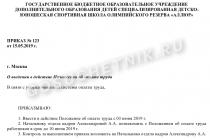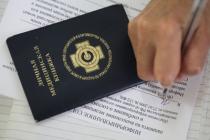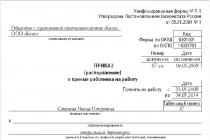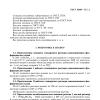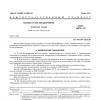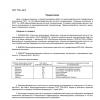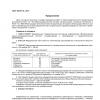The duration of the annual basic paid leave is 28 calendar days (Article 115 of the Labor Code of the Russian Federation). According to the first part of Art. 125 of the Labor Code of the Russian Federation, by agreement between the employee and the employer, annual paid leave can be divided into parts. At the same time, at least one of the parts of this vacation must be at least 14 calendar days.
As can be seen from the rule above, labor law a requirement was established regarding the minimum duration of only one part of the vacation when it is divided into parts. Nothing is said about the duration of the other part of the annual paid leave in the Labor Code of the Russian Federation. Consequently, the other part of the vacation can be divided by agreement of the parties into parts, which can be of any duration.
According to Art. 120 of the Labor Code of the Russian Federation, the duration of the vacation is calculated in calendar days. The law does not establish how many calendar days of vacation should fall on weekends, and how many on workdays. Therefore, vacation days exceeding 14 can be granted to the employee in parts in such a way that they will fall only on working days or only on weekends, or on both in any ratio.
Therefore, the employee and the employer can agree on how many days off and how many working days will fall on the part of the vacation that exceeds 14 calendar days. If the employee and the employer have agreed to give the employee a vacation, the last day of which will be Friday, the next two days off (Saturday and Sunday) should not be included in the number of vacation days and should not be paid.
At the same time, we note that the employer always retains the right to disagree with the option for breaking down the vacation proposed by the employee.
Please note that, in accordance with Art. 8 of the ILO Convention N 132 on holidays with pay (hereinafter referred to as the Convention), when dividing the holiday into parts, one of the parts of the holiday must be at least two continuous working weeks. In other words, Article 8 of the Convention, as well as Article 125 of the Labor Code of the Russian Federation, establishes the minimum duration of only one part of the vacation. The Convention also does not provide that weekends (Saturday and Sunday) must be included in the number of vacation days.
We also recommend that you read the Federal Service on labor and employment of July 17, 2009 N 2143-6-1.
For your information:
Employer for general rule recognized individual or a legal entity (organization) that has entered into an employment relationship with an employee (part four of article 20 of the Labor Code of the Russian Federation). If an organization has entered into labor relations, the rights and obligations of the employer in labor relations are carried out by its management bodies or persons authorized by them in the manner established by the Labor Code of the Russian Federation, other federal laws and other regulatory legal acts of the Russian Federation, laws and other regulatory legal acts of the constituent entities of the Russian Federation, regulatory legal acts of bodies local government, founding documents legal entity(organizations) and local regulations (part six of article 20 of the Labor Code of the Russian Federation). So, the CEO is the sole executive body societies with limited liability(hereinafter - LLC) (Article 40 federal law dated February 8, 1998 N 14-FZ "On Limited Liability Companies"). Thus, the rights and obligations of an LLC in labor relations are exercised CEO(sole executive management body) or persons authorized by it.
Prepared answer:
Legal Consulting Service Expert GARANT
Troshina Tatiana
The answer passed the quality control by the legal consulting service GARANT
The material was prepared on the basis of an individual written consultation provided as part of the Legal Consulting service.
Summer is the season of universal zeal for the sea and the sun. At the same time, the accountant begins a hot time at the workplace. The reason is the controversial issues that arise almost more than employees seeking to relax. Let's consider the most important of them.
Gives answers to questions Victoria Bespalova, Leading Consultant, Head of Department labor law NS Consulting.
1. What is the minimum number of vacation days an employee can take? If an employee leaves on Monday after a vacation, does he have the right not to include the previous weekend in the vacation period?
The purpose of annual paid leave is to restore the physical and moral strength of the employee and, in general, it must be at least 28 calendar days per year of work. The possibility of splitting the vacation into parts is provided, with the condition that at least one of them is at least 14 calendar days (Article 125 of the Labor Code). It is not known how many parts the remaining 14 days can be divided into - there are no relevant instructions from the legislation.
Article 128 Labor Code states: “for family reasons and other valid reasons, an employee, upon his written application, may be granted leave without saving wages, the duration of which is determined by agreement. At the same time, the Code does not stipulate that such leave should be taken into account in calendar days. Thus, the situation of registration of leave without pay for the days from Monday to Friday is quite acceptable, which cannot be said about the next annual paid leave. Articles 115 and 120 of the Labor Code clearly establish the procedure for granting the next annual paid leave in calendar days.
When dividing the vacation into small parts, the employer directly violates the requirements of these articles by providing vacation not in calendar days, but in working days.
It is worth remembering that the concept of "calendar days" is not tied to the days when the employee works and when he rests in fact. Working days clearly refer to the days when the employee was supposed to work (Article 14 of the Labor Code).
As for the amount of accrued vacation pay, if the last two days off are not included in the vacation period, then, of course, based on the foregoing, the amount of vacation pay will be reduced by two calendar days.
Answer to this question depends on whether the employee has already received an increased salary for the period of the last 12 calendar months preceding the calculation of vacation pay, or not. If yes, then in accordance with paragraph 16 of Decree No. 922, when calculating average earnings for calculating vacation pay, a multiplying factor should be applied. It is determined simply: the new salary must be divided by the salary before the increase. The salary should be recalculated from the beginning of the billing period to the month of increase.
Let's analyze a specific example. An employee goes on vacation from July 21, 2010. The settlement period for calculating average earnings - from July 1, 2009 to June 30, 2010 - has been fully worked out. Until May 31, 2010, the employee's salary was 20,000 rubles, from June 1 - 25,000 rubles. The coefficient is taken as 1.25 (25,000 rubles: 20,000 rubles). In the amount of payments for calculating the average salary for each month from July 2009 to May 2010, instead of the actually paid amount (20,000 rubles), you need to take the estimated amount, that is, 25,000 rubles. (20,000 rubles x 1.25). Thus, the total amount for determining the average earnings will be 300,000 rubles. (20,000 rubles x 11 months x 1.25 + 25,000 rubles x 1 month).
When an employee is granted leave with subsequent dismissal, the last day of leave is considered the day of dismissal.
When billing period not fully worked out, the number of calendar days in incomplete months and fully worked out is determined separately. The total amount of payments is divided by the sum of the found values. To find the number of calendar days in incomplete month, you need 29.4 (the average monthly number of calendar days in accordance with Article 139 of the Labor Code of the Russian Federation) divided by the number of calendar days of a given month and multiplied by the number of calendar days worked in this month.
For example, from May 17 to May 23, 2010 (7 calendar days), an employee was ill. For May, he was paid a salary in the amount of 9,000 rubles. and paid sick leave in the amount of 2000 RUB. The salary of an employee is 12,000 rubles. The employee is granted leave in the amount of 28 calendar days.
The number of calendar days in May will be 22.76 days (29.4: 31 days x 24 days). The amount of actually accrued wages for the billing period from March 2009 to April 2010 will be 141,000 rubles. (12,000 rubles x 11 months + 9,000 rubles). Thus, the average daily earnings of an employee will be equal to 407.33 rubles. (141,000 rubles: (29.4 x 11 + 22.76), which means that the amount of vacation pay will be 11,405.24 rubles (407.33 rubles x 28 days).
4. What period should be taken to calculate vacation pay if an employee goes on vacation in the middle of the month?
In accordance with article 139 of the Labor Code and paragraph 4 of Decree No. 922, the period for calculating vacation pay depends on the actual wages accrued.
Let's take an example. Terms of payment of wages in accordance with the employment contract and the rules of internal work schedule as follows: the first half of the salary is paid on the 20th day of the reporting month, and the second half on the 5th day of the month following the reporting month. Let's assume that the employee is granted leave from August 15, 2010. To calculate the average earnings, we will take the period for which wages have already been accrued. Thus, August will not be included in this period, since the second part of the salary for August will be accrued to the employee only on September 5, 2010, and vacation pay for an employee must be paid three days before the start of the holiday. Therefore, the settlement period will be from June 1, 2009 to July 31, 2010.
5. How is a vacation with subsequent dismissal formalized? Does an employee have the right to take paid leave instead of a two-week work? What day will be considered the last working day?
In accordance with the opinion of Rostrud (letter dated December 24, 2007 No. 5277-6-1), the provision of leave with subsequent dismissal is the right of the employer, and not his obligation. If an employee expresses a desire to go on annual leave instead of a two-week processing, he needs to write an application. Further, the employer decides whether to grant such leave to the employee or not. If the employer agrees with the state of affairs, a corresponding resolution appears on the application. Next, an order is issued to grant leave, an appropriate mark is made on the T-2 personal card, and vacation pay is issued.
In accordance with the same letter of Rostrud No. 5277-6-1, when an employee is granted leave with subsequent dismissal in the afternoon
dismissal is considered the last day of vacation. However, all calculations are made before the employee goes on vacation, since at the end of it the parties will no longer be bound by obligations. The same should be done with work book and other documents that the employer is obliged to provide to the employee. They must be issued before going on vacation. This point of view is also confirmed by the ruling of the Constitutional Court dated January 25, 2007 No. 131-О-О.
Every employee is entitled to annual paid leave, and separate categories employees also on additional paid holidays. The procedure for granting holidays is regulated by the Labor Code of the Russian Federation, which means that it must be strictly observed. Consider how to send an employee on annual leave correctly.
STEP 1: SEND A NOTIFICATION OF THE BEGINNING OF HOLIDAY OR RECEIVE AN EMPLOYEE'S STATEMENT
Until now, many personnel officers doubt whether the employee needs to write an application for vacation. Let's figure it out.
As you know, the order in which vacations are granted is determined by the vacation schedule (part one of Article 123 of the Labor Code of the Russian Federation). The employer approves the schedule no later than two weeks before the beginning of the year for which it is drawn up. The schedule is approved taking into account the opinion of the trade union (if any) (part one of article 123 of the Labor Code of the Russian Federation). After the vacation schedule is approved, it becomes mandatory for the employee and the employer (part two of article 123 of the Labor Code of the Russian Federation).
This rule does not apply to those categories of employees to whom the employer is obliged to provide annual leave at a convenient time for them. These include:
- husbands while their wives are on maternity leave (part four of article 123 of the Labor Code of the Russian Federation);
- combat veterans (Federal Law No. 5-FZ of January 12, 1995 “On Veterans”, as amended on December 19, 2016);
- “Chernobyl victims” (clause 5, article 14 of the Law of the Russian Federation of May 15, 1991 No. 1244-1 “On social protection citizens exposed to radiation as a result of a catastrophe at Chernobyl nuclear power plant", in red. dated December 28, 2016);
- employees whose spouses are military personnel (clause 11, article 11 of the Federal Law of May 27, 1998 No. 76-FZ “On the Status of Military Personnel”, as amended on April 3, 2017);
- external part-time workers who are granted leave simultaneously with leave for their main job (part 1 of article 286 of the Labor Code of the Russian Federation);
- Heroes of the Soviet Union, Heroes Russian Federation, full holders of the Order of Glory (clause 3, article 8 of the Law of the Russian Federation dated January 15, 1993 No. 4301-1 “On the status of Heroes of the Soviet Union, Heroes of the Russian Federation and full holders of the Order of Glory” as amended on July 2, 2013, as amended from 12/19/2016).
Vacation notice
There is no approved form of notification of the start time of the vacation, so the employer should develop it on his own. However, please note that the document must contain the following information:
- name of company;
- outgoing number and date of registration of the document;
- position, surname and initials of the employee;
- Name structural unit;
- deadlines for the annual leave;
- employer's signature.
Note! The employee must receive a notice of the start time of the vacation (Example 1) against signature no later than two weeks before the start of the vacation (part one of article 123 of the Labor Code of the Russian Federation).
According to the approved vacation schedule, Secretary Ilyina N.B. must go on vacation from 06/17/2017 to 06/30/2017. Familiarize yourself with the notice of the start time of the vacation in this case, Ilyina N.B. must not later than 06/02/2017.
If several employees go on vacation, you can notify them with one document (Example 2). It should be noted that two weeks before the vacation is the minimum period, you can notify earlier.
According to the schedule, employees go on vacation on various days of July - from 07/01/2017 to 07/31/2017. 2017. This means that all employees who go on vacation in July can be notified on June 12. For those who go on vacation on 07/01/2017, the warning period will be minimal, for everyone else - more than the minimum.
Leave application
The application form for granting leave is also not provided for by law, therefore, upon receiving the employee’s application, it is necessary to check whether all the necessary details are present in the document, namely:
- name of the employing organization;
- position, surname and initials of the head;
- the position of the employee and the name of the structural unit;
- surname and initials of the employee.
In the text of the application, the employee indicates what kind of vacation he is asking for (main or additional), the start date of the vacation and the number of vacation days.
The employee signs the application with his own hand and puts down the date. Next, the head puts an approval visa on the application.
To simplify the process and reduce the number of errors, the organization can develop an application form - employees will only have to fill it out. However, the completed application form must also contain the employee's handwritten signature (Example 5).
Annual leave must be applied for in advance. This will allow the manager to find a replacement for the employee during the vacation, and the accounting departments to calculate vacation pay, which must be paid no later than three days before the start of the vacation (part nine of article 136 of the Labor Code of the Russian Federation).
If the employer violates this requirement of the law, he pays the employee monetary compensation(Article 236 of the Labor Code of the Russian Federation). To avoid disputes, it is better to fix the deadlines for the provision of such applications in the local normative act, for example, in the Internal Labor Regulations:
We recommend registering notices of the start of vacation and applications for its provision in a special journal (Example 6). This will avoid disputes about the date of submission of the application.
STEP 2. CHECK WHAT VACATION IS ALLOWED FOR THE EMPLOYEE
As a general rule, employees are granted annual paid leave of 28 calendar days (Article 115 of the Labor Code of the Russian Federation).
So, entitled to additional paid leave:
- workers whose working conditions are classified as harmful and dangerous - at least 7 calendar days (Article 117 of the Labor Code of the Russian Federation);
- workers with irregular working hours - at least 3 calendar days a year (Article 119 of the Labor Code of the Russian Federation);
- persons working in the regions of the Far North and equivalent areas - from 8 to 24 calendar days (Article 321 of the Labor Code of the Russian Federation, Article 14 of the Law of the Russian Federation of February 19, 1993 No. 4520-1 "On state guarantees and compensations for persons working and living in the regions of the Far North and areas equivalent to them, ed. dated December 31, 2014);
- doctors general practice and them nurses for continuous work in these positions for more than three years - 3 days (Decree of the Government of the Russian Federation of December 30, 1998 No. 1588 "On the establishment of general practitioners (family doctors) and nurses of general practitioners (family doctors) of annual additional paid 3-day leave for continuous work in these positions”);
The following have the right to annual extended paid holidays:
- employees with an assigned disability group - 30 calendar days (Article 23 of the Federal Law of November 24, 1995 No. 181-FZ "On the Social Protection of Persons with Disabilities in the Russian Federation", as amended on March 7, 2017);
- workers educational institutions- duration of 56 or 42 calendar days, depending on the type of institution and position (Decree of the Government of the Russian Federation dated May 14, 2015 No. 466 “On annual basic extended paid holidays”, as amended on April 7, 2017);
- staff scientists of universities: Doctors of Science - 48 working days, Candidates of Sciences - 36 working days (Decree of the Government of the Russian Federation of August 12, 1994 No. 949 "On annual vacations of scientific workers with an academic degree");
- workers involved in work with chemical weapons - 56 or 49 calendar days );
- employees of healthcare organizations that diagnose and treat HIV-infected patients - 36 working days (Decree of the Government of the Russian Federation dated 03.04.1996 No. 391 “On the procedure for granting benefits to employees who are at risk of contracting the human immunodeficiency virus in the performance of their official duties”).
- workers under the age of 18 (part 3 of article 122, article 267 of the Labor Code of the Russian Federation);
- employees who have adopted a child (or children) under the age of three months (part 3 of article 122 of the Labor Code of the Russian Federation);
- women before maternity leave or immediately after it (part 3 of article 122 of the Labor Code of the Russian Federation).
STEP 3: CALCULATE EXPERIENCE FOR VACATION
After the personnel officer has decided on the duration of the main and additional vacation, it is necessary to calculate how many vacation days the employee has earned.
To do this, you should calculate the length of service that gives the right to receive leave. After all, if the employee has not yet earned a vacation, then by providing the vacation in advance, the employer risks. Not always, upon dismissal, an employee is paid a salary sufficient to withhold payment for vacation days used in advance.
The length of service, which gives the right to receive annual regular paid leave, is calculated from the first day of work with the employer. The working year is calculated from the day the employee is hired and ends at the end of the working year. The working year does not coincide with the calendar, so each employee has his own period of the working year.
Arinin M.A. admitted to the organization on May 16, 2016. The first working year of the employee begins on May 16, 2016 and ends after 12 months of continuous work, that is, it lasts until May 15, 2017. The second working year - from 05/16/2017 to 05/16/2018, etc.
Please note that not all periods when the employee was listed in the organization can be included in the length of service, which gives the right to the provision of regular annual paid leave (Article 121 of the Labor Code of the Russian Federation).
Work experience includes:
- working time in the organization;
- the time when the employee did not work, but the place of work was retained for him (time of annual paid leave, non-working holidays, days of temporary disability, days off and other days of rest);
- forced absence time illegal dismissal or suspension from work and subsequent reinstatement;
- the period of suspension from work of an employee who has not passed the mandatory medical checkup through no fault of their own;
- vacation time without pay, not exceeding 14 calendar days during the working year.
Annual leave does not include:
- time away from work good reasons;
- time of parental leave;
- vacation time without pay, exceeding 14 calendar days during the working year.
- Calculation of the length of service for annual leave if the employee used less than 14 calendar days of leave without pay in the working year.
Let's give an example of calculating the length of service for vacation.
Arinin M.A. adopted on May 16, 2016. The employee applied for annual leave from 06/05/2017 for 14 calendar days. At the same time, from November 14, 2016 to November 20, 2016, the employee was granted annual paid leave in the amount of 7 calendar days, and on December 30, 2016 he used 1 day of leave without pay. Also Arinin M.A. was on sick leave from 02/20/2017 to 02/24/2017.
● For the working year from 05/16/2016 to 05/15/2017 Arinin M.A. as a general rule, 28 calendar days of vacation are required. Since the time of annual leave and temporary disability is included in the length of service for granting annual leave, we take into account these periods in the length of service.
● Marinin M.A. also used 1 day of unpaid leave in the working year. However, since the total number of days does not exceed 14 calendar days, this day is also included in the length of service.
● From the total number of days due for the working period, you must subtract the days of vacation already used. Thus, Arinin M.A. for the period from May 16, 2016 to May 15, 2017:
28 k.d. annual leave - 7 k.d. vacation used = 21 k.d.
The employee has accumulated the required number of vacation days, and vacation in the amount of 14 calendar days can be granted to him.
- Calculation of the length of service for annual leave, if the employee in the working year used more than 14 calendar days of leave without pay.
If an employee used leave without pay for a period of more than 14 calendar days, this period is also not included in the calculation of the length of service in accordance with Art. 121 of the Labor Code of the Russian Federation (see also the letters of Rostrud dated June 14, 2012 No. 854-6-1; dated December 18, 2012 No. 1519-6-1).
The employee was accepted on 09/11/2015. From 12/05/2016 to 12/30/2016, the employee was granted 26 days of unpaid leave.
The period of service giving the right to grant annual leave includes only the period of leave without pay in the amount of 14 calendar days. The remaining days are not included in the vacation period and “shift” the border of the working year by 12 calendar days (26 - 14 \u003d 12) 12 days).
- Calculation of seniority for additional leave for "harmful" work.
Additional leave is planned (as well as annual) in the vacation schedule. However, the length of service, which gives the right to additional annual paid leave for work with harmful or dangerous working conditions, includes only the time actually worked under these conditions (part three of article 121 of the Labor Code of the Russian Federation).
According to paragraphs 8 and 9 of the Instructions on the procedure for applying the List of production shops, professions and positions with harmful working conditions, work in which gives the right to additional leave and a reduced working day (approved by the Decree of the USSR State Committee for Labor, All-Union Central Council of Trade Unions dated November 21, 1975 No. 273 / P-20, as amended on January 26, 2017), full additional leave is provided if the employee actually worked in industries, workshops, professions and positions with harmful working conditions for at least 11 months. If an employee worked during the working year harmful conditions less than 11 months, then he is granted additional leave in proportion to the hours worked.
To calculate the length of service giving the right to the specified leave, it is necessary to calculate the number of days that the employee actually worked in hazardous working conditions (at least half the working day). Next, you should determine the number of full months of work in harmful or dangerous working conditions. To calculate the number of full months of work in hazardous working conditions, it is necessary to divide the total number of days of such work during the year by the average monthly number of working days. If the balance is less than half of the average monthly number of working days, it is excluded from the calculation, if half or more, it is rounded up to the full month (Rostrud letter No. 657-6-0 of March 18, 2008).
The employee was hired as a gas cutter on July 27, 2016. The employee applied for annual leave from 06/12/2017 for 14 calendar days and additional annual leave from 06/26/2017 for 12 calendar days (according to the collective agreement). From November 21, 2016 to November 27, 2016, the employee was granted annual paid leave in the amount of 7 calendar days.
For the working year from 07/27/2016 to 07/26/2017, the employee, as a general rule, is entitled to 28 calendar days of vacation, as well as 12 days of additional vacation. Calculate the number of vacation days for work in harmful working conditions.
At the time of the expected start of additional leave, the employee will work in harmful conditions from 07/27/2016 to 06/26/2017, which is 11 months. Since the employee has worked for at least 11 months, the employee is granted a full additional vacation in the amount of 12 calendar days.
From the total number of days due to the employee for a given period, you need to subtract the period of vacation already used.
Thus, for the period from 07/27/2016 to 07/26/2017, the employee is entitled to:
28 k.d. annual leave + 12 k.d. additional leave - 7 k.d. vacation used = 33 k.d.
The employee was hired as a driver on 10/24/2016. He applied for annual leave from 06/19/2017 for 14 calendar days and additional annual leave from 07/03/2017 for 8 calendar days (according to the collective agreement). The employee has not used his vacation yet.
At the time of the expected start of additional leave, the employee will work in harmful conditions from 10/24/2016 to 07/02/2017, which is 8 months. Since the employee has worked less than 11 months, it is necessary to calculate the number of days of additional leave. To do this, you need to determine the number of days in which the employee actually worked in harmful working conditions for at least half the duration of the working day.
For example, an employee worked full time. Then for the calculation we apply the formula:
124 days of work in hazardous conditions / 29.4 ( average monthly working days) = 4.22 k.d.
Thus, on 07/03/2017, the employee is entitled to 4 calendar days of additional leave.
For the working year from 10/24/2016 to 10/23/2017, the employee is entitled to 21 calendar days of basic annual leave (9 months worked × 2.33 days). The employee is also entitled to 4 calendar days of additional leave.
The employee has accumulated the required number of days of the main annual leave. The employer also provides the employee with additional leave in the amount of 4 calendar days.
STEP 4: ISSUING A VACATION ORDER
If there are no obstacles for the employee to go on vacation, an order can be issued. Most often, it is compiled according to the unified form No. T-6 (Examples 7, 8) (approved by the Decree of the State Statistics Committee of Russia dated 01/05/2004 No. 11), but the employer has the right to develop his own form. The employee gets acquainted with the order against signature.
STEP 5: WE MAKE A CALCULATION NOTE
To calculate other payments due to the employee when providing him with annual paid or other leave, you need to draw up a note-calculation (Example 9). It is compiled according to the unified form No. T-60 or according to the form approved by the organization.
A note-calculation must be transferred to the accounting department for calculating vacation pay and paying them to the employee.
STEP 6: INTRODUCING DATA TO THE PERSONAL CARD OF THE EMPLOYEE
After issuing the order, the personnel service needs to enter the vacation data in the employee's personal card (form No. T-2 or in the form of the organization) (Example 10).
STEP 7: COUNTING DAYS OF VACATION IN THE TIME REPORT
The employer maintains a time sheet in the form of No. T-13 or in the form approved by the organization. On the time sheet for without fail days of annual paid leave are also taken into account. The days when the employee is on vacation must be indicated by the code OT or 09 (Example 11).

STEP 8: INTRODUCING DATA TO THE HOLIDAY SCHEDULE
The organization must approve the vacation schedule no later than two weeks before the start of the new calendar year. When creating a vacation schedule, you can use unified form No. T-7, but the employer has the right to develop his own form.
As employees use vacations, information on the actual use of vacations is entered into the schedule.
Sometimes there are changes to the schedule. For example, if an employee asks to postpone his annual paid leave to another time (and the employer agrees), extend the employee's vacation (for example, due to disability that occurred during the vacation) or recall the employee from vacation.
After the application is submitted, changes to the vacation schedule must be made. Sometimes changes to the schedule are made by order, but the Labor Code of the Russian Federation does not provide for such an obligation. In our opinion, in this case it is sufficient to refer to the employee's statement in column 8 (Example 12).

SUMMARY
1. When arranging a vacation for an employee according to the schedule, it is necessary to send the latter a notice of the beginning of the vacation two weeks in advance
before it starts.
2. If an employee wishes to go on vacation outside the schedule, he must apply
to the employer with a statement. The employer has the right to agree with the provision of vacation outside the schedule or refuse the employee.
4. By agreement of the employee and the employer, the vacation can be postponed according to the schedule.
5. When calculating the length of service for vacation, it is necessary to take into account periods that are not included in the length of service, which entitles you to the provision of an annual regular paid
holidays.
6. Following the procedure, personnel service must issue an order on the provision of the main annual paid leave, draw up a note-calculation, make entries in the employee’s personal card, reflect the leave in the time sheet and enter information in the schedule
holidays.
How many vacation days are allowed per year?
As a general rule, the number of paid vacation days per year must be at least 28 (Article 115 of the Labor Code of the Russian Federation). Is it 28 calendar days or working days? The annual main paid leave is considered in calendar days (Article 120 of the Labor Code of the Russian Federation). That is, for each working year, the employee is entitled to 28 calendar days.
Dividing vacation into parts
An employee does not have to use all 4 weeks of vacation due to him at a time. Leave may be divided by agreement between the employee and the employer. The division of vacation into parts according to the Labor Code of the Russian Federation must be done in such a way that the duration of at least one of the parts is at least 14 calendar days (Article 125 of the Labor Code of the Russian Federation). Subject to this condition, the duration of other parts of the vacation may be an arbitrarily small number of days, including 1 or 2 days.
How long does an employee's vacation last, taking into account weekends and holidays
Weekend days falling within the period of vacation are taken into account when calculating its duration and are subject to payment. Let's explain with an example. Manager Ivanov A.K. wrote an application for leave for the period from June 17 to June 23, 2019. June 22 and 23 are days off. Accordingly, the employee must be granted leave for 7 days and all 7 days must be paid.
Unlike ordinary days off, public holidays are not included in the duration of the vacation and are not paid (Article 120 of the Labor Code of the Russian Federation). Let's go back to the example above. If Ivanov A.K. will write an application for June 6-13 - 8 calendar days, only 7 calendar days will be credited and paid for vacation. Because June 12 is a holiday (Article 112 of the Labor Code of the Russian Federation).
Vacation: the number of days according to the legislation and according to the local act
The specified vacation duration - 28 calendar days - is the minimum according to the Labor Code of the Russian Federation. And the employer, on his own initiative, can establish paid leave of longer duration for his employees. The number of additionally provided paid vacation days (in addition to 28) must be indicated in the collective agreement, the local regulatory act of the organization (for example, internal labor regulations) or directly in employment contracts with workers.
It is important that the cost of paying for such additional vacation days cannot be taken into account for income tax purposes (clause 24, article 270 of the Tax Code of the Russian Federation). Also, from the amount of their payment, it will be necessary to withhold personal income tax and accrue insurance premiums(Clause 2, Article 226 of the Tax Code of the Russian Federation, Clause 1 of Article 420 of the Tax Code of the Russian Federation).
Extended leave under the Labor Code 2019: how many days
Who is entitled to apply for extended basic leave and how many vacation days should be provided to these persons is indicated in the table.
| Category of workers | Number of vacation days under the Labor Code and other legislative acts |
|---|---|
| Workers under the age of 18 | 31 calendar days. Leave must be granted at any time convenient for the minor (Article 267 of the Labor Code of the Russian Federation) |
| Working disabled people with any disability group | At least 30 calendar days (Article 23 of the Law of November 24, 1995 No. 181-FZ) |
| Teaching staff | 42 or 56 calendar days depending on the position held and type educational organization where a teacher works (Article 334 of the Labor Code of the Russian Federation, paragraph 3 of part 5 of Article 47 of the Law of December 29, 2012 No. 273-FZ, Appendix to the Decree of the Government of the Russian Federation of May 14, 2015 No. 466) |
| Researchers with a degree | — 48 working days for PhDs; — 36 working days for candidates of sciences. These extended holidays are granted scientists occupying positions in a scientific institution (organization) financed from federal budget(Decree of the Government of the Russian Federation of 12.08.1994 No. 949) |
| Chemical weapons workers | 56 or 49 calendar days, depending on the group of work to which the employee's activity is assigned. The assignment of works to the first or second group depends on the degree of their danger (Articles 1, 5 of the Law of November 7, 2000 No. 136-FZ) |
| Employees of professional emergency rescue services and formations | 30, 35 or 40 days, depending on the duration of continuous work experience in professional emergency rescue services and formations (clause 5, article 28 of the Law of August 22, 1995 No. 151-FZ) |
| Healthcare workers at risk of contracting the human immunodeficiency virus | 36 working days for employees of healthcare organizations that diagnose and treat HIV-infected people, as well as people whose work is related to materials containing the human immunodeficiency virus, taking into account the annual additional leave for working in hazardous working conditions (paragraph 4 of the Government Decree RF dated 03.04.1996 No. 391) |
| Government civil servants | 30 calendar days (part 3 of article 46 of the Law of July 27, 2004 No. 79-FZ) |
| Prosecutors, scientific and teaching staff prosecutor's office | paragraph 1 of Art. 41.4 of the Law of January 17, 1992 No. 2202-1). |
| Employees Investigative Committee serving not in areas with special climatic conditions | 30 calendar days excluding travel time to the place of rest and back in the general case (part 1 of article 25 of the Law of December 28, 2010 No. 403-FZ). |
Additional leave
Some employees, in addition to the main leave (standard or extended), are also entitled to additional leave. You can read about such a vacation at.
How many days is the "northern" leave by law
How many days does a northerner's vacation last? Usually more than non-Northern workers. After all, the "northerners", firstly, are provided with the main annual paid leave - of a standard duration or extended in the above cases. And secondly, they are provided with additional leave (Article 321 of the Labor Code of the Russian Federation). For workers who work:
- in the regions of the Far North - 24 calendar days;
- in areas equivalent to the regions of the Far North - 16 calendar days;
- in other regions of the North, where the regional coefficient and the percentage bonus to wages are established, - 8 calendar days (Article 14 of the Law of the Russian Federation of February 19, 1993 No. 4520-1).
By the way, both regular annual paid holidays and extended, as well as additional "northern" holidays can be provided to employees in advance (
Several factors influence the duration of additional leave for work in harmful working conditions and the amount of vacation pay.
Employees employed in hazardous working conditions should be granted additional paid leave every year. Its minimum duration is 7 calendar days. These rules are set:
- in part 1 of article 116 and article 117 of the Labor Code of the Russian Federation;
- Clause 1 of Decree of the Government of the Russian Federation of November 20, 2008 N 870 "On the establishment of reduced working hours, annual additional paid leave, increased wages for workers engaged in heavy work, work with harmful and (or) dangerous and other special working conditions."
The duration of the annual additional paid leave is determined by the results of the certification of workplaces in terms of working conditions. The procedure for attestation of workplaces in terms of working conditions was approved by the order of the Ministry of Health and Social Development of Russia dated April 26, 2011 N 342n “On Approval of the Procedure for Certification of Workplaces in Terms of Working”.
Specific norms for the duration of additional paid leave, depending on the profession (position) of the employee, are established by the List of industries, workshops, professions and positions with harmful working conditions, work in which gives the right to additional leave and a shorter working day, approved by the Decree of the State Committee for Labor of the USSR, the Presidium of the All-Union Central Council of Trade Unions of October 25 .74 N 298/P-22 (hereinafter referred to as the List).
In the List, the duration of the additional leave provided is set in the range from 6 to 36 working days.
Before the adoption of a new procedure for providing compensation to workers employed in hazardous working conditions, the List can be applied if its provisions are included in the collective agreement or local regulations adopted by the employer (part 3 of article 219 of the Labor Code of the Russian Federation, information from the Ministry of Labor of Russia dated 13.02.2013, letter of Rostrud dated 19.06.2012 N PG / 4463-6-1).
Vacation period for additional leave
Employees who have actually worked in hazardous conditions for at least 11 months have the right to additional leave in full.
In all other cases, its duration is calculated in proportion to the hours worked. This procedure is established by paragraph 9 of the Instruction approved by the Decree of the USSR State Committee for Labor, the All-Union Central Council of Trade Unions of November 21, 1975 N 273 / P-20 “On approval of the Instruction on the procedure for applying the List of industries, workshops, professions and positions with harmful working conditions, work in which gives the right to additional vacation and shortened working hours” (hereinafter referred to as the Instruction).
The list, as well as the Instruction, are valid in the part that does not contradict the Labor Code (part 1 of article 423 of the Labor Code of the Russian Federation).
The employee worked in hazardous conditions for less than a month
Workers go on vacation, fall ill, take vacations at their own expense, etc. In practice, rarely does anyone work out the full number of months in hazardous conditions, usually several months and several days. In this case, it is necessary to determine how many full months the employee actually worked in harmful conditions.
Example 2. A. B. Baryshev works as a gas welder according to a five-day calendar working week. According to the results of certification of workplaces for work in harmful working conditions, he is entitled to an additional paid leave of 14 calendar days per working year, this is stated in the local document of the organization.
In the period from March 11 to September 30, 2013 (inclusive), A. B. Baryshev worked 140 full days in hazardous conditions.
Solution. According to the calendar of the five-day working week in 2013, 247 working days. The average monthly number of working days is 20.58 (247 working days: 12 months).
The number of full months for which the employee is entitled to additional paid leave is 6.8 (140 working days: 20.58 days / month), the result is rounded up to 7.
The duration of additional paid leave for work in hazardous working conditions in calendar days is 8.17 (14 calendar days: 12 months x 7 months).
The local document of the organization reflects the rules for rounding up to a whole number of calendar days of vacation - in favor of the employee.
The employee is entitled to an additional vacation of 9 calendar days.
Different harmful factors - different duration of additional leave
If during the working year the employee worked in different industries or in different positions for work in which additional leave of unequal duration is provided, the calculation of the time worked in hazardous working conditions is carried out separately for each job.
Example 3. A. E. Antonov works full-time as a house painter according to a six-day working week calendar.
In the period from January 25 to April 30, 2013 (inclusive), A. E. Antonov worked 78 full working days in hazardous working conditions, for which work is entitled to leave of 14 calendar days per working year.
And from May 1 to September 20, 2013, he was transferred to work, for which 7 calendar days of additional leave per working year are required. During this period, he worked 116 full days.
Solution. According to the calendar of the six-day working week in 2013, 299 working days. The average monthly number of working days is 24.92 (299 working days: 12 months).
The number of full months for which an employee is entitled to additional paid leave is:
- 3.13 months (78 working days : 24.92 days / month);
- 4.65 months (116 working days : 24.92 days / month).
Length of additional paid leave
- for work in hazardous working conditions is:
- for 3.13 months - 3.65 calendar days (14 calendar days: 12 months x 3.13 months);
- for 4.65 months - 2.71 calendar days (7 calendar days: 12 months x 4.65 months).
The total duration of additional leave is 6.36 calendar days (3.65 calendar days + 2.71 calendar days).
The employee must be granted 7 calendar days of additional leave.
Two vacations - one amount of vacation pay
When calculating total duration of annual paid leave, the period of additional paid leave is summed up with the period of the annual main paid leave (part 2 of article 120 of the Labor Code of the Russian Federation, clause 14 of the Rules on regular and additional holidays, approved by the USSR Tax Code of 04.30.30 N 169). This means that both holidays are granted consecutively without interruption one after the other. Accordingly, vacation pay for both holidays must be issued no later than three days before the start of the first of them (part 9 of article 136 of the Labor Code of the Russian Federation).
Every day of vacation is paid from the average wage of the employee.
As a general rule, the calculation of average earnings to determine the amount of vacation pay is based on the wages actually accrued to the employee and the time actually worked by him for the billing period.
The duration of the calculation period for determining the average earnings is 12 calendar months preceding the month of the start of the vacation. Base:
- part 3 of article 139 of the Labor Code;
- paragraphs 1, 2 and 4 of the Regulations, approved by the Decree of the Government of the Russian Federation of December 24, 2007 N 922.
A collective agreement or a local normative act may also provide for other periods for calculating the average wage, if this does not worsen the position of employees (part 6 of article 139 of the Labor Code of the Russian Federation).
In this case, when calculating vacation pay for annual paid and additional leave, the billing period and the amount of payments taken into account will be the same. However, since the number of days of annual paid leave is calculated calendar days, and additional - workers, the accountant will have difficulty in determining the value of the average daily earnings.
This problem can be avoided by ensuring the comparability of the indicators of the number of days, namely: you need to convert working days into calendar days.
Methods for converting working days into calendar days
The legislation does not establish rules for converting working days of additional paid leave into calendar days. In practice, two methods are used:
- calendar;
- mathematical.
The rules for recalculating vacation working days into calendar days must be established in the company's internal documents - a local regulatory act or a collective agreement.
calendar method
- a certain number of days of the main vacation in calendar days is counted from the start date of the vacation;
- from the date following the last day of vacation, a certain number of days of additional vacation in working days is calculated based on a six-day working week;
- after that, the total vacation period (from the first to the last day) is translated into calendar days.
Example 4. An employee was granted an annual basic paid leave from September 2, 2013 with a duration of 28 calendar days and additional leave - 9 working days according to the schedule of a six-day working week. The employee is not a seasonal worker, he has an indefinite employment contract.
What will be the duration of the additional vacation in calendar days and what date will the employee go to work?
Solution. calendar count. Vacation starts on Monday.
We determine the end date of the main vacation, this is September 29, 2013 (September 2 (inclusive) + 28 calendar days).
From September 30, 2013, we count 9 working days of additional paid leave (according to the calendar of a 6-day working week). The last day of vacation will be October 9, 2013.
The total duration of the vacation will be 38 calendar days. The employee must start work on October 10, 2013.
When applying the calendar method, the total duration of the vacation depends on which day of the week the vacation begins. Let's show this with an example.
Example 5. Let's use the condition of example 4, changing only the start date of the vacation - September 6, 2013.
Solution. calendar count. Vacation starts on Friday.
We determine the end date of the main vacation - October 3, 2013 (28 calendar days from September 6).
From October 4, 2013, we count 9 working days of additional paid leave (according to the calendar of a 6-day working week).
The last day of vacation will be October 14, 2013. The employee must return to work on October 15, 2013.
In this case, the total duration of the vacation will be 39 calendar days.
mathematical method
The dependence of the total duration of the vacation on which day of the week the paid vacation begins makes it possible to avoid the use of the mathematical method of converting working days into calendar days.
Its essence is to calculate the ratio of calendar and working days per calendar week (7 calendar days: 6 working days).
This ratio is a constant used in all subsequent calculations, regardless of the specific conditions for granting holidays.

















